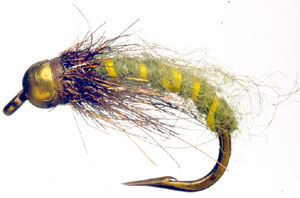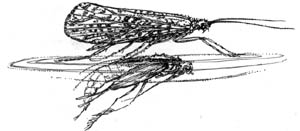Caddisflies
Order: Trichoptera
Family: Limnephilidae (one of many)
Indentifying
Features
Caddisflies are also known as sedges. Unlike the dragons and damsels,
sedges have complete metamorphosis with larval, pupal and adult stages.
Larvae:
Larval cases are built from surrounding material, such as sand,
small stones, tiny twigs or bits of vegetation. Larvae go through several
molts and build a new home to accommodate each successively larger stage.
The larval stage can last from one to two years. Coloration is extremely
varied, but green and yellow are important. Sizes range is from one-half
to four cm.
Pupae:
Once the final molt is complete, the larvae seal themselves
in their homes and undergo the transformation to the pupal stage. Pupae
cut their way out of the cases and swim slowly to the surface. Fully
formed adults emerge from the split pupal shuck and rest while the wings
dry. To get airborne, they scamper across the surface forming a trailing
vee across the water. Color and size range is as for larvae.
Adults:
After mating, females return to the water to deposit their eggs by lowering
their abdomens into the water. Usually the females remain in constant
motion while laying their eggs. Tan is the most important color as this
is the typical wing coloration. Body color is varied, but green -- everything
from forest green to bright emerald -- and yellow are important.
What
to Look For
Adults are easily recognizable by their moth-like appearance and by
the way they carry their wings when at rest, like a traditional A-frame
style tent. Large moth-like creatures scampering across the water's
surface are caddisflies. Larvae are identified by their cases. Pupae
of the types most important to interior waters have a long, dangling
set of legs used as oars during the surface swim. This and their even
longer antennae, laid back across the body, identify them.
Life
Cycle
Many details are provided above, but note that when pupae emerge from
the larval cases, they are sheathed in a membrane with only their oar-like
legs protruding to help them swim. Hatching most often occurs as soon
as the surface is reached; the membrane splits down the back and the
adult heaves itself free. This may take some time. Adults wing their
way to shoreside vegetation to rest. Mating normally follows some weeks
later and is most often done in the air. Females of some species enter
the water and lay their eggs on the bottom, others drop them while flying
over and still others by lowering their abdomens into the water.
 |
|
|
When
to Fish
Again, emergence is a function of elevation and weather, but the last
two weeks of June and into early July are typical peak emergence times.
They can continue through to September. Late morning to midafternoon
seem to be the peak hours for emergence, but late-night hatches are
a sedge hallmark. Any sign of sedges on the surface calls for either
adult or pupal imitations, especially if the naturals are large. Emergence
times on individual lakes vary little from year to year; diaries are
the way to keep track.
How
to Fish
Kamloops trout noisily ripping large caddisflies flies from the surface
of a Thompson-Nicola lake makes for an angling experience hard to top
anywhere in the world. Deerhair flies and drylines are used, but for
all that has been said and written about dry-fly fishing and the sedge,
it is often pupal imitations which take the most fish; the trout will
key to them while ignoring the large adults veeing the surface. Pupal
imitations can be fished just subsurface with dry lines or from top
to bottom with appropriate lines. Best bottom to top retrieve consists
of a series of short twitchy pulls followed by a pause, then a fairly
long pull, pause and twitch again.
 |
|
|
Fishing
Tip
Body color of adults can be vital, especially once the hatch has developed
to the stage where the fish are well-fed and fussy. Remember fish look
up from below at the sedge and body color is the first thing they see.
Pupae struggle mightily to free themselves from their shucks; trout
often key very specifically on this stage, a good thing to remember
when fishing the adult amidst splashy rises with no results. Even if
no diary is kept, record the time, date and location of any strong sedge
hatch encountered. Next year's hatch will be a repeat almost to the
minute, provided that similar weather conditions prevail.
Be sure
to visit Fishbc.com for angling information!
Back to introduction


















